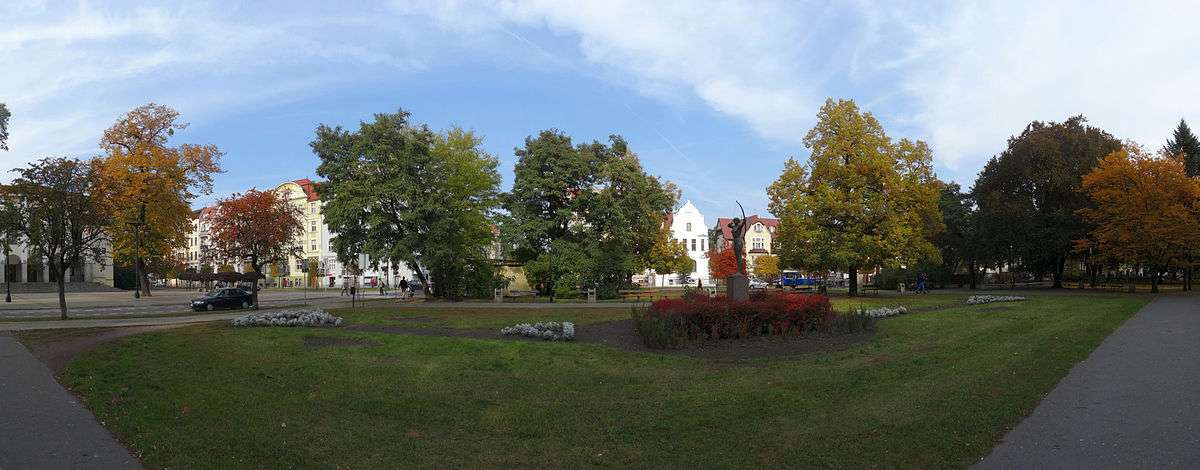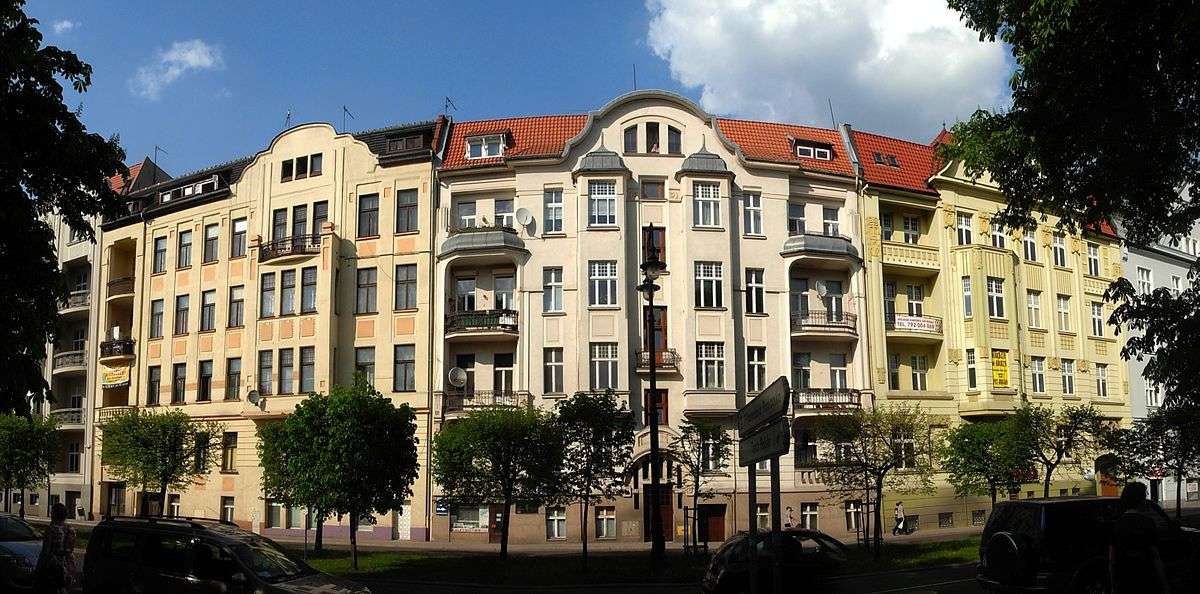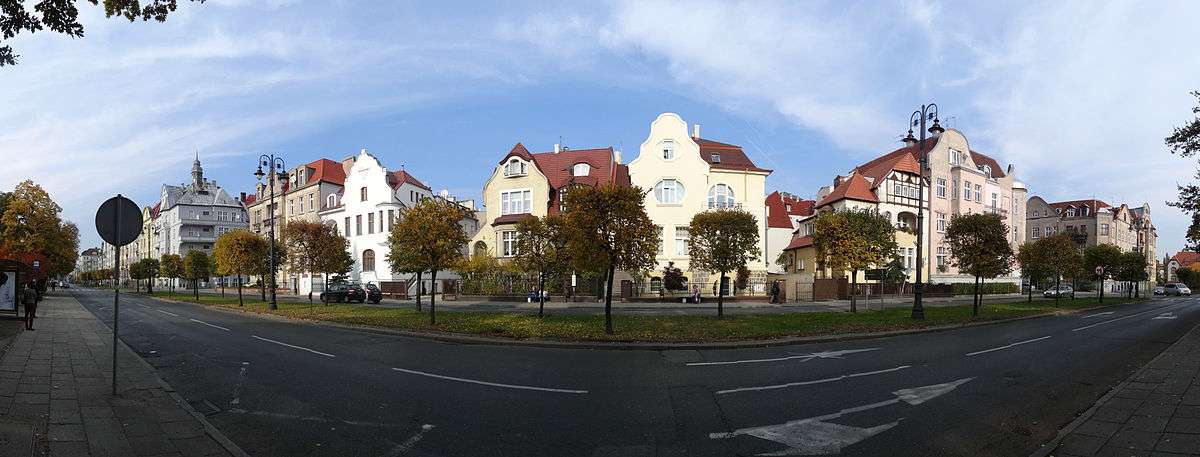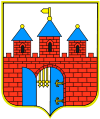Adam Mickiewicz Alley in Bydgoszcz
Adam Mickiewicz Alley is one of the main streets of downtown district in Bydgoszcz, where several buildings are registered on the Kuyavian-Pomeranian Voivodeship Heritage List.
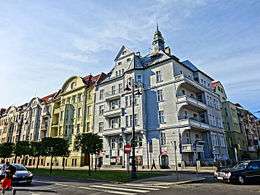
| Bydgoszcz | |
|---|---|
 View of the street | |
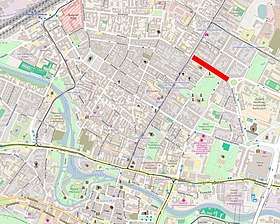 Location of Adam Mickiewicz Alley | |
| Native name | Polish: Aleja Adama Mickiewicza w Bydgoszczy |
| Part of | Bydgoszcz Old town district |
| Namesake | Adam Mickiewicz |
| Owner | City of Bydgoszcz |
| Length | 400 m (1,300 ft) |
| Location | Bydgoszcz |
Location
The street links Gdańska Street to Józef Weyssenhoff Square. Its northern frontage is a set of tenements and villas built in the first decade of the 20th century. On the southern side are located the Polish Theatre and Jan Kochanowski Park.
Naming
Adam Mickiewicz Alley
- 1906-1920, Bülowstraße, after Bernhard von Bülow;
- 1920-1939, Aleje Adama Mickiewicza after Adam Mickiewicz;
- 1939-1945, Felix-Dahn-Straße, after Felix Dahn;
- Since 1945, Aleje Adama Mickiewicza
Józef Weyssenhoff Square
- 1906-1920, Bülowplatz, after Bernhard von Bülow;
- 1920-1933, Plac Zacisze ("Tranquility Square")
- 1933-1939, Plac Józefa Weyssenhoffa, after Józef Weyssenhoff, Polish writer and literary critic, who lived at No.1 from 1924 to 1928;[1]
- 1939-1945, Johann Fichte Platz, after Johann Gottlieb Fichte;
- Since 1945, Plac Józefa Weyssenhoffa.
History
Adam Mickiewicz Alley
Adam Mickiewicz Alley has been laid out in 1903, in the conditions of an urban development of the eastern area of Gdańska Street called "Hempelscher Felde":[2] this plot was bought in the 1890s by the municipality to develop its urban plans based on a garden city concept developed by Hermann Stübben.[3]
The highlight of the whole project was the Bülow street, then one of the most beautiful and widest thoroughfare of the city. It comprised a dual carriageway starting from Dantziger strasse, running eastward. The perspective was particularly taken care of, emphasized by a row of trees, with stretched garlands of vines.[4] At the same time, the Ossolińscy street, continuation of the axis from Weyssenhoff square, was defined in its main features.
The northern frontage of Adam Mickiewicz Alley has been conceived from 1903 to 1907 as an homogeneous complex of Berlin Art Nouveau tenements, similar to what has been erected at the same time in Dworcowa Street (No.45, 47, 49). In 1910, an addition to the frontage, consisting of villas and houses has been erected. The perspective of the street to the east has been closed by the building of the Institute of Agriculture (Ger. Kaiser-Wilhelm-Institut für Landwirtschaft), then the first high school scientific department in Bromberg.[2]
In 1949, the Polish Theatre has been completed, standing at the intersection with 20 January 1920 Street. In 1960, the Archer Statue has been moved from Theatre square to Jan Kochanowski Park. Most of the facade decorations and reliefs have been deteriorated by lack of treatment during the post-war years.[5]
The street has undergone a gradual revitalization after 1990. Between 2002 and 2009, all street facades have been was renovated, and, when possible, restored with their original decorations.

Józef Weyssenhoff Square
The square was founded in 1903 in the same conditions as Adam Mickiewicz Alley. It is a triangular square from which radiate:[6]
- Adam Mickiewicz Alley in a north-westerwards,
- Ossolińscy street (Ger. Hohenzzolernstrasse) to the south-east.
In the middle was planted flowerbeds, shrubs and trees. In 1926, coniferous and deciduous trees were put.[7] Between 1905 and 1911, a frontage of five-story apartment buildings have been built, following Art Nouveau and Historicism styles.
Jan Kochanowski Park
This green estate runs on the southern side of Adam Mickiewicz Alley, between January 20, 1920 street on the west and Ignac Paderewski street on the east, extending to the south till the Pomeranian Philharmonic.
 "The Archer" by Ferdinand Lepcke, author also of the Deluge Fountain
"The Archer" by Ferdinand Lepcke, author also of the Deluge Fountain "The Archer" with the Polski theatre in the background
"The Archer" with the Polski theatre in the background Monument to Henryk Sienkiewicz
Monument to Henryk Sienkiewicz "The Archer" by night
"The Archer" by night
Architecture
Frontages of Mickiewicz alley (No.1 to 9) and Józef Weyssenhoff Square compose a complex of townhouses inscribed in the German variant of Art Nouveau architecture (Ger. "Jugendstil"). Predominant forms evoke quietness, through varied bay windows, divided balconies and loggias integrating wavy lines, wavy gables, vaulted windows and portals. Decoration combines organic themes with geometric forms, like rectangular and square shapes, grouped in series and friezes. The ensemble reminds also Baroque style at by applying domes avant-corps and towers topped with peaks.[8]
The architects who designed those buildings were all inspired by Berlin architecture, "en vogue" at the time:[9]
- Rudolf Kern who built also tenements in Gdańska Street at No.5, No.67, No.66-38, No.71;
- Erich Lindenburger who constructed also in Dworcowa Street (No.41,43,45,47);
- Paul Böhm who realized houses on August Cieszkowski Street in Bydgoszcz at No.1 and 3;
- Otto Rosenthal;[10]
- Józef Święcicki, known for its dozens of realization in Gdańska Street.
For almost the entire post-war period, tenements have been property of the state. In 1990, the city of Bydgoszcz owned them back, but at the time, they were falling into disrepair as a result of underinvestment, lack of maintenance and general neglect of Art Nouveau monuments. Buildings have been restored after 2002.
Main places and buildings
Rudolf Kern Building, at No.1, corner with Gdańska Street
Registered on Kuyavian-Pomeranian Voivodeship heritage list, No.601377-Reg.A/1086 (November 20, 1995)[11]
1903-1904, by Rudolf Kern[12]
The tenement has been designed by the architect Rudolf Kern, a student of Józef Święcicki, for his own use, private and business: he has lived there until 1922.
- View from Mickiewicz Alley
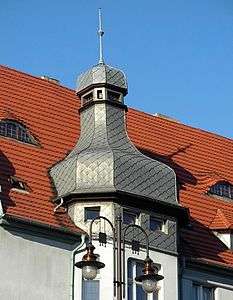 Detail of the peak
Detail of the peak- The ornamented gate
Polish Theatre in Bydgoszcz, at No.2
1948-1949, by Alfons Licznerski
Hieronim Konieczka Polish Theatre in Bydgoszcz is the largest and best known theatre of the city. It is set at No.2. Current director is Paweł Wodziński.
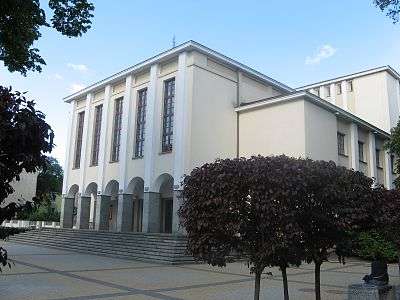 View from Mickiewicz Alley
View from Mickiewicz Alley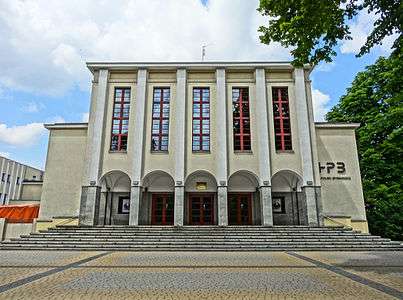 Main entry
Main entry View from Jan Kochanowski Park
View from Jan Kochanowski Park
Tenement at No.3
1904-1905,[12] by Erich Lindenburger
The building was originally commissioned by a merchant, Georg Woodtke.[13]
Characteristic features are the adorned portal and decorative gable; the façade has pilaster strips which accentuates vertical divisions. Bay windows are divided with loggias. This building is the seat of the Honorary consulate of Czech Republic.
 View of the frontage from Mickiewicz Alley
View of the frontage from Mickiewicz Alley Detail of the tinned roofed bay window
Detail of the tinned roofed bay window Grandiose front gate
Grandiose front gate Front gate top
Front gate top
House at No.4, corner with Paderewskiego street
1906-1908[12]
This building displays highly decorated balconies and bay windows. The roof boasts eyelid dormers.
 View of the frontage from Mickiewicz Alley
View of the frontage from Mickiewicz Alley- Detail of portal and loggia
- Detail of the gable with eyelid dormer
House at No.5
Registered on Kuyavian-Pomeranian Voivodeship heritage list, No.601378, Reg.A/1081 (December 21, 1994)[11]
1906,[12] by Rudolf Kern
The tenement was first ordered by Adolf Berger, a merchant.[13]
Less adorned than its neighbours, this building displays anyhow the same Art Nouveau grandeur, with loggias and bay windows, as well as a curved top frontage and dormers on the gable.
- View of the frontage from Mickiewicz Alley
- The house and its flanking neighbours
Rosenthal building at No.7
Registered on Kuyavian-Pomeranian Voivodeship heritage list, No.601379, Reg.A/1082 (January 10, 1995)[11]
1904-1905,[12] by Rudolf Kern
The tenement was commissioned by the brothers Rosentjal, Otto and Theodor, who also co-developed the project.[13]
No.7 looks like a mirrored shape of No.5, underlying the seal of the same Art Nouveau architect. Frontage adornament is much richer, with loggias, balconies and bay windows topped by helmet-style roof.
- View of the frontage from Mickiewicz Alley
 Detail of the roof
Detail of the roof- Gate at No.7
Tenement at No.9
Registered on Kuyavian-Pomeranian Voivodeship heritage list, No.601380-Reg.A/855 (August 28, 1985)[11]
1905-1906,[12] by Rudolf Kern
The house was built by Bydgoszcz architect Rudolf Kern so as to establish the first private music school in the city, the Conservatoire of Bydgoszcz (German: Bromberger Konservatorium der Musik).[10] The school was founded in 1904 on the initiative of Arnold Schattschneider and was originally located at Gdańska Street 24, (German: Dantzigerstrasse 158).[14] The space in the building was soon too scarce, and decision was made to build a new edifice at Adam Mickiewicz Alley, using the opportunity of the urban development of the "Hempelscher Feldethe" area. Construction lasted from December 1905 to October 1906 when an opening concert took place for the opening of the new school premises.[10]
The building displays Art Nouveau style, using rich decorative forms. The facade is balanced with vertical and horizontal lines as well as balconies having each their own designed railing. The main entrance had two doors: one leading to the staircase to the conservatoroire, the other going to private spaces for the landlord and the school headmaster.[10] Inside, the school housed classrooms, instruments, an extensive library and a concert hall with Neo-Baroque features.[10] In the concert hall was organized symphonic concerts, chamber music events, concerts of students and monthly subscription concerts. In smaller venues were classes for piano, violin, cello and choral singing. Teachers of the conservatoire came from Vienna, Dresden, Regensburg, Prague, Rome, Moscow and Warsaw, classes comprised Germans and Poles.[10] Wilhelm von Winterfeld, second director since 1914, had the school moved in the early 1930s to larger premises at Gdańska Street, 54[15] (from where it moved again to Gdańska Street 71 in 1939). The interiors of the building in Adam Mickiewicz Alley have been entirely rebuilt to turn classrooms and auditorium into flats.[2] In 2002-2004 a major renovation of the facade has been carried out, giving back to the frontage its original design that had been lost since the postwar period.[2]
 Advert. for Bydgoszcz Music Conservatoire ca 1906
Advert. for Bydgoszcz Music Conservatoire ca 1906 View ca 1915, as "Bromberger Konservatorium"
View ca 1915, as "Bromberger Konservatorium" Frontage view from the street
Frontage view from the street- Art Nouveau ornamentation above the portal
 Stucco decor of the top level
Stucco decor of the top level Window's adornment
Window's adornment
Corner house with January 20, 1920 street
Registered on Kuyavian-Pomeranian Voivodeship heritage list, No.601456-Reg.A/1080/1-2 (December 20, 1994)[11]
1905-1906[12]
This corner house is characterised by its towering peak topped with a tin roof.
 View ca 1914
View ca 1914 General view of both frontages
General view of both frontages- Facade on Mickiewicz Alley
- Facade on January 20, 1920 street
Corner house with January 20, 1920 street
1903[12]
This corner house displays also a nice adorned portal.
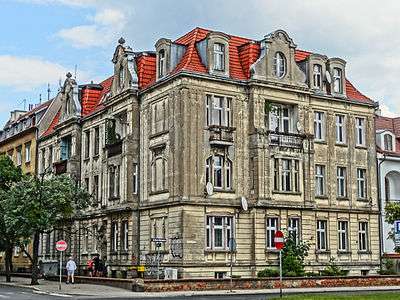 General view of both frontages
General view of both frontages Detailed view of facade decoration
Detailed view of facade decoration Detail of the gate ornamentation
Detail of the gate ornamentation
Villa at No.11
1903-1904,[12] by Ludwig Otto Wirpelius.[13]
One of the few villas built during the initial development of the street.
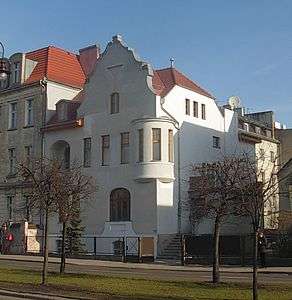 General view of the villa
General view of the villa- Detail of a facade window
Villas at No.13/15
Registered on Kuyavian-Pomeranian Voivodeship Heritage List, No.6601381-Reg. A/1067 (May 18, 1994)[11]
1903-1904,[12] by Rudolf Kern.[13]
One of the few villas built during the initial development of the street, both commissioned by Julius Berger, a merchant.[13] During the interwar period, the villa at No.15 housed a clinic run by Dr. Staemmler.[16]
 Villa at No.15 in 1912
Villa at No.15 in 1912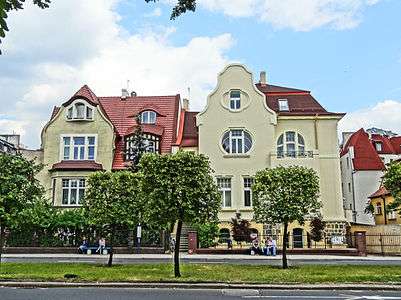 General view of villas
General view of villas- Facade of Villa at No.15
- Detail of the gate of villa at No.15
Villa Józef Święcicki at No.17
1906[12]
German Historicism
This villa was one of the buildings Bydgoszcz's architect Józef Święcicki realized for himself (see also Józef Święcicki tenement in Bydgoszcz).[13]
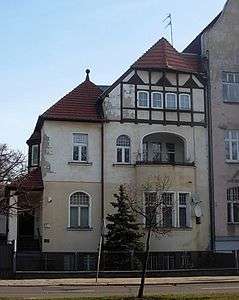 General view of the villa
General view of the villa- Detail of the gate of Villa Józef Święcicki
Sculpture The awaking of the elves (Polish: Przebudzenie Elfów)
1906[12]
The carve has been realized in the trunk of a dead tree in 2006, by Zbyszko Piwoński.[17] The artist has realized other similar sculptures at Gdańska Street 30 - (Woman with pigeons, 2006 Polish: Kobieta w gołębiach) and in Słowackiego Street - (We'll be playing soon, 2010 - Polish: Zaraz zagramy).[17]
 The awaking of the elves
The awaking of the elves The awaking of the elves
The awaking of the elves
Corner house at Paderewskiego street No.1
1905-1908[12]
This corner house displays typical tin roof above each of its bay windows.
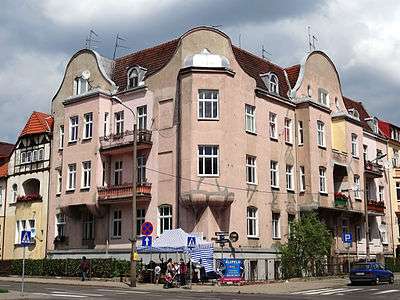 General view of both frontages
General view of both frontages
Corner house at Paderewskiego street No.10
1905-1907[12]
This corner house starts the series of frontages characteristic of Józef Weyssenhoff Square.
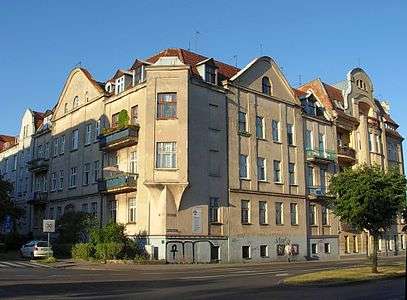 General view of both frontages
General view of both frontages
Tenement at Józef Weyssenhoff Square No.1
1905-1906, by Rudolf Kern
This is the house Józef Weyssenhoff lived in from 1924 to 1928; a plaque has been placed on the facade in memoriam. Both facades display bay windows with loggias or balconies. A richly decorated frieze runs at the bottom of the gable boasting dormers.
 General view of frontages
General view of frontages Detail of stuccoed motifs
Detail of stuccoed motifs Adorned door
Adorned door- Plaque on memoriam of J. Weyssenhoff
Tenement at Józef Weyssenhoff Square No.2
1927, by Bogdan Raczkowski[18]
Modern Architecture
House on the border of the Sielanka district, displaying a mix of functionalist style (left side) and eclectic shapes (right side) with a loggia and Mansard roof.
 General view of frontages
General view of frontages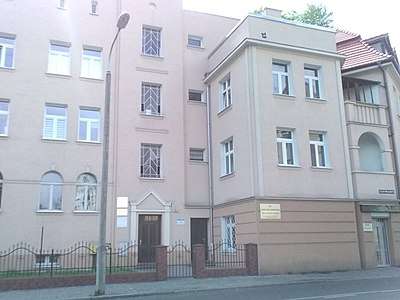 Functionalist facade
Functionalist facade Detail of portal decoration
Detail of portal decoration
Tenement at Józef Weyssenhoff Square No.3
1905-1910, by Erich Lindenburger
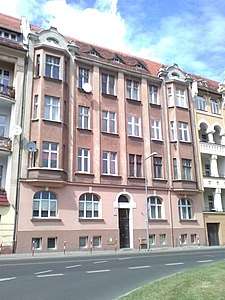 Main elevation
Main elevation Main elevation
Main elevation Portal detail
Portal detail
Tenement at Józef Weyssenhoff Square No.4
1933[11]
Modern Architecture
Functionalist edifice, abutted to No.2.
 View of No.4 (forefront), with No.2 in the background.
View of No.4 (forefront), with No.2 in the background.
Tenement at Józef Weyssenhoff Square No.5
Registered on Kuyavian-Pomeranian Voivodeship heritage list, No.743201-Reg.A/1573 (October 29, 2010)[11]
1908-1909, by Paul Böhm
The facade display 3 levels of balconies. The building has been recently refurbished.
House at Józef Weyssenhoff Square No.6
1934-1935, by Dzielinski Konstanty[19]
Modern Architecture
Functionalist house, similar to buildings down Ossoliński Alley.
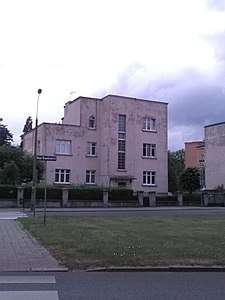 View from Ossoliński Alley.
View from Ossoliński Alley.
Tenement at Józef Weyssenhoff Square No.7
1909-1910
The facade is characterised by a balanced, even symmetry around the large arcade running above the entry gate. This round motif is recurrent through the whole frontage, from the ground level arcades up to the curved pediment.
 Main elevation
Main elevation Detail of the curved pediment
Detail of the curved pediment- Main gate portal
- Adornement of the portal
Tenement at Józef Weyssenhoff Square No.9
Registered on Kuyavian-Pomeranian Voivodeship heritage list, No.725836-Reg.A/1522 (March 20, 2009)[11]
1910-1911, by Georg Baesler
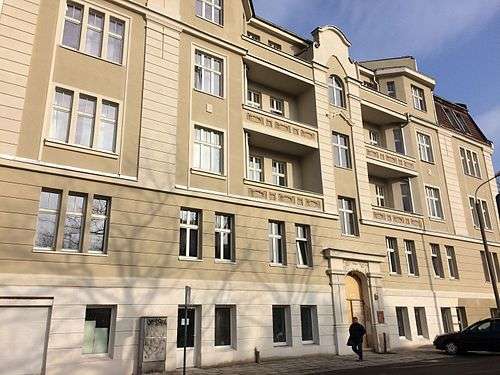 General view 2016
General view 2016- Detail of the entry gate
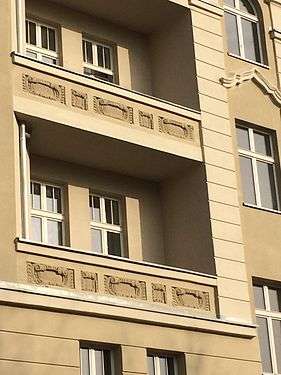 Motifs details
Motifs details
Building of the Institute of Agriculture
Registered on Kuyavian-Pomeranian Voivodeship heritage list, No.601254-Reg.A/676/1-8 (May 20, 1992)[11]
Józef Weyssenhoff Square No.11
1903-1906, by H. Delius
The architectural ensemble of the Institutes of Agriculture in Bydgoszcz occupies an area of 7.5 hectares, between J. Weyssenhoff Square, Ossolińsky Alley, Powstańców Wielkopolskich Alley and Karol Szymanowski Street. The western area is laid out with buildings, the eastern one is a 5 ha zone of field vegetation, with livestock, greenhouses and a barn.[20]
 Institutes of Agriculture ca 1908
Institutes of Agriculture ca 1908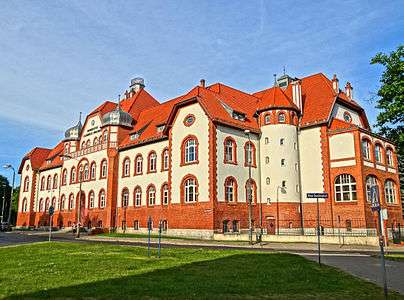 General view from Plac J. Weyssenhoff
General view from Plac J. Weyssenhoff Main avant-corps with tin roof, the observatory on top
Main avant-corps with tin roof, the observatory on top Main gate
Main gate Transom light and its decorated cartouche
Transom light and its decorated cartouche
See also
| Wikimedia Commons has media related to Mickiewicza Street in Bydgoszcz. |
- Bydgoszcz
- Polish Theatre in Bydgoszcz
- Pomeranian Philharmonic
- Gdańska Street, Bydgoszcz
- Ossoliński Alley in Bydgoszcz
References
- Umiński, Janusz: Bydgoszcz. Przewodnik, Regionalny Oddział PTTK "Szlak Brdy" Bydgoszcz 1996. s. 115
- Jastrzębska-Puzowska, Iwona: Od miasteczka do metropolii. Rozwój architektoniczny i urbanistyczny Bydgoszczy w latach 1850-1920. Wydawnictwo MADO. Toruń 2005. ISBN 83-89886-38-3, 978-83-89886-38-5
- Bydgoszcz Guide. Bydgoszcz: City of Bydgoszcz. July 2014. p. 22. ISBN 83-917786-7-3.
- Bręczewska-Kulesza Daria, Derkowska-Kostkowska Bogna, Wysocka A., [i inni]: Ulica Gdańska. Przewodnik historyczny, Bydgoszcz 2003
- Umiński, Janusz: Bydgoszcz. Przewodnik, Regionalny Oddział PTTK "Szlak Brdy" Bydgoszcz 1996
- Okoń Emanuel, Tandecki Janusz. Bydgoszcz - historia i rozwój przestrzenny. [w.] Czachorowski Antoni red.: Atlas historyczny miast polskich. Tom II Kujawy. Zeszyt I Bydgoszcz. Uniwersytet Mikołaja Kopernika. Toruń 1997
- Kuczma Rajmund: Zieleń w dawnej Bydgoszczy. Instytut Wydawniczy "Świadectwo". Bydgoszcz 1995
- Bręczewska-Kulesza Daria: Wielkomiejska kamienica czynszowa w Bydgoszczy na przełomie XIX i XX wieku. [w.] Materiały do dziejów kultury i sztuki Bydgoszczy i regionu. Zeszyt 12. Pracownia Dokumentacji i Popularyzacji Zabytków Wojewódzkiego Ośrodka Kultury w Bydgoszczy. Bydgoszcz 2007
- Daria Bręczewska-Kulesza-Wpływ architektury i architektów berlińskich na bydgoskie budownictwo mieszkaniowe na przełomie XIX i XX stulecia.
- Majchrzak, Agnieszka (1996). Bydgoskie Konserwatorium Muzyczne. Materiały do Dziejów Kultury i Sztuki Bydgoszczy i Regionu. zeszyt 1. Bydgoszcz: Pracownia Dokumentacji i Popularyzacji Zabytków Wojewódzkiego Ośrodka Kultury w Bydgoszczy. p. 41.
- zabytek|kujawsko-pomorskie|issued=1.03.2014
- Gminna Ewidencja Zabytków Miasta Bydgoszczy. [w:] Program Opieki nad Zabytkami miasta Bydgoszczy na lata 2013-2016
- Bręczewska-Kulesza, Daria (2004). Nowoczesna dzielnica mieszkaniowa z początku XX w. Kronika Bydgoska T26. Bydgoszcz: Towarzystwo Miłosnikow Miasta Bydgoszczy - Bydgoskie Towarzystwo Naukowe. p. 82.
- Adressbuch nebst allgemeinem Geschäfts-Anzeiger von Bromberg und dessen Vororten auf das Jahr 1905 : auf Grund amtlicher und privater Unterlagen. Bromberg: Dittmann. 1905. p. 16.
- Księga Adresowa Miasta Bydgoszczy : 1936/37, p.XXV
- "Alfabetyczny s pis ulic i placów". Książka adresowa misata Bydgoszczy. Bydgoszcz: Bibljoteka polska w Bydgoszczy. 1929. p. 14.
- Bydgoskie Centrum Informacji (2014). "Rzeźby w pniach drzew". visitbydgoszcz.pl. Bydgoskie Centrum Informacji. Retrieved 25 August 2018.
- Wysocka, Agnieszka (2004). Bogdan Raczkowski - architekt i urbanista międzywojennej Bydgoszczy.Materiały do dziejow kultury i sztuki bydgoszczy i regionu zeszyt 8. Bydgoszcz: Pracownia dokumentacji i popularyzacji zabytków wojewódzkiego ośrodka kultury w Bydgoszczy. pp. 465–485.
- Derkowska - Kostkowska, Bogna (2004). o założeniu Sielanki - bydgoskiego miasta ogrodu. Materiały do dziejow kultury i sztuki bydgoszczy i regionu Zeszyt 4. Bydgoszcz: Pracownia dokumentacji i popularyzacji zabytków wojewódzkiego ośrodka kultury w Bydgoszczy. p. 84.
- Grzybowska Maria, Werterowska Zofia (1999). Przyczynki do historii architektury zespołu naukowych Instytutów Rolniczych w Bydgoszczy. Bydgoszcz: Pracownia Dokumentacji i Popularyzacji Zabytków Wojewódzkiego Ośrodka Kultury w Bydgoszczy. p. 60.
External links
Bibliography
- (in Polish) Majchrzak Agnieszka: Bydgoskie Konserwatorium Muzyczne. [w.] Materiały do dziejów kultury i sztuki Bydgoszczy i regionu. Zeszyt 1. Pracownia Dokumentacji i Popularyzacji Zabytków Wojewódzkiego Ośrodka Kultury w Bydgoszczy. Bydgoszcz 1996
- (in Polish) Bręczewska-Kulesza, Daria: Przegląd stylów występujących w bydgoskiej architekturze drugiej połowy XIX i początku XX stulecia
- (in Polish) Bręczewska-Kulesza Daria, Derkowska-Kostkowska Bogna, Wysocka A., [i inni]: Ulica Gdańska. Przewodnik historyczny, Bydgoszcz 2003
- (in Polish) Jastrzębska-Puzowska, Iwona: Od miasteczka do metropolii. Rozwój architektoniczny i urbanistyczny Bydgoszczy w latach 1850-1920. Wydawnictwo MADO. Toruń 2005. ISBN 83-89886-38-3, 978-83-89886-38-5
- (in Polish) Umiński, Janusz: Bydgoszcz. Przewodnik, Regionalny Oddział PTTK "Szlak Brdy" Bydgoszcz 1996
- (in Polish) Antoni Czachorowski (red.) Atlas historyczny miast polskich. Tom II Kujawy. Zeszyt 1. Bydgoszcz. Uniwersytet Mikołaja Kopernika, Toruń 1997
- (in Polish) Rajmund Kuczma Zieleń w dawnej Bydgoszczy. Instytut Wydawniczy "Świadectwo". Bydgoszcz 1995
